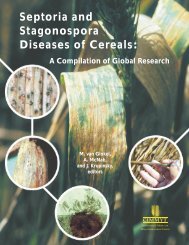Section 3 (Crop Management)
Section 3 (Crop Management)
Section 3 (Crop Management)
You also want an ePaper? Increase the reach of your titles
YUMPU automatically turns print PDFs into web optimized ePapers that Google loves.
Experimental Findings (Based on station and farmers field trial):<br />
Quayyum<br />
Sowing time<br />
Sowing time is the most important factor in the development and growth of crop species. Very often<br />
the sowing of maize in the winter season gets delayed due to late harvest of preceding crops like rice. A<br />
study was undertaken to investigate the effect of sowing date on the yield of different hybrid maize at<br />
RARS Jamalpur. The experiment was conducted during the period from October 2001 to April 2002. The<br />
soil of the experimental site belongs to the Old Brahmaputra flood Plain (AEZ-9) and the texture of the<br />
soil was silty loam with a pH value of 6.5. The treatments included in the experiment were from four<br />
varieties: BARI hybrid maize-1, CMS-933072, Pioneer, and Pacific-11, on four sowing dates: Oct. 30,<br />
Nov.15, Nov. 30, and Dec. 15. Fertilizer was applied@ 250-120-120-40-5 N-P205-K20-S and Zn kg/ha,<br />
respectively.<br />
The results showed that length of cob, grains/cob, 100-grain weight, grain yield, and stover yield were<br />
significantly influenced by variety. Grains/cob showed identical statistics between V2, V3 & V4 , but V1<br />
showed lower grain weight (Table 1). The variety CMS933072 revealed higher grain weight but on par to<br />
Pacific 11. There was higher grain yield obtained from variety CMS933072 but it was statistically<br />
identical to variety Pacific 11. BARI hybrid maize-1 revealed the lowest grain yield among the varieties.<br />
But in the case of straw yield V3 & V2 were statically identical. Plant height, yield, and yield attributes<br />
were significantly influenced by sowing date except grain/cob, which was not varied (Table 1). October<br />
sowing revealed a higher number of gains/cob and 100-grain weight, which reflected high grain yield.<br />
There was a trend to decrease yield with the advancement of dates. Stover yield was not influenced by<br />
different dates of sowing. Interaction between variety and sowing date was influenced by 100-grain<br />
weight and grain and straw yield (Table 2). Grain yield showed higher in V2 D2 but statically identical to<br />
V4D1, V4D2, and V2D1. It revealed that sowing October 30 to November 15 gave higher yield in hybrid<br />
variety CMS933-72, followed by variety Pacific 11.<br />
Varietal performance at farmers’ field and On-station<br />
The experiment was conducted at MLT site Jhenaidah, Jessore during rabi 2001-2002. The<br />
experiment was laid out in RCB design with 5 replications. The unit plot was 4.5 x 5m with 75x50 cm<br />
spacing (1 plant/hill). The varieties CMS9330722, BMS9902, BHM-1, and Pacific –11 were used. The<br />
seeds were sown on 25 November, 2001. Fertilizer dose 250-120-120-40-5kg N P2O5K20 and Zn were<br />
applied. The results showed that days to maturity, plant height, ear height, length of cob, grains/cob, 100grain<br />
weight, and grain yield were significantly influenced by different varieties (Table 3). The hybrid<br />
line BHS9902 took longest time whereas Pacific 11 took the shortest duration. Plant height was<br />
statistically at par except BHM-1, which showed lower plant height. Significantly highest length of cob<br />
was obtained from hybrid line CMS933072, whereas other varieties were statistically identical.<br />
Grains/cob showed higher in CMS933072 but significantly no difference with other varieties except<br />
BHM-1, which produced lower number of grains. The hybrid line CMS933072 and Pacific 11 showed<br />
similar grain weight higher than the other two varieties. Significantly highest grain yield was obtained<br />
from hybrid line CMS 933072. Other hybrid varieties/lines were statistically identical and significantly<br />
lower than CMS933072. The hybrid line CMS933072 showed higher grain yield due to higher grain/cob,<br />
grain weight, and length of cob. So, it showed that hybrid line CMS933072 could be grown in the Jessore<br />
region for higher yield.<br />
On-station experiments were conducted at ARS, Rangpur during 2001-2002. The result showed that<br />
days to maturity, plant height, plants/m 2 , grains/cob, 100 seed weight, and grain yield was significantly<br />
influenced by different hybrid varieties. Hybrid variety Pacific 11 showed highest duration whereas<br />
- 237 -









